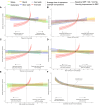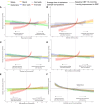Device-Measured 24-Hour Movement Behaviors and Blood Pressure: A 6-Part Compositional Individual Participant Data Analysis in the ProPASS Consortium
- PMID: 39504653
- PMCID: PMC11732261
- DOI: 10.1161/CIRCULATIONAHA.124.069820
Device-Measured 24-Hour Movement Behaviors and Blood Pressure: A 6-Part Compositional Individual Participant Data Analysis in the ProPASS Consortium
Abstract
Background: Blood pressure (BP)-lowering effects of structured exercise are well-established. Effects of 24-hour movement behaviors captured in free-living settings have received less attention. This cross-sectional study investigated associations between a 24-hour behavior composition comprising 6 parts (sleeping, sedentary behavior, standing, slow walking, fast walking, and combined exercise-like activity [eg, running and cycling]) and systolic BP (SBP) and diastolic BP (DBP).
Methods: Data from thigh-worn accelerometers and BP measurements were collected from 6 cohorts in the Prospective Physical Activity, Sitting and Sleep consortium (ProPASS) (n=14 761; mean±SD, 54.2±9.6 years). Individual participant analysis using compositional data analysis was conducted with adjustments for relevant harmonized covariates. Based on the average sample composition, reallocation plots examined estimated BP reductions through behavioral replacement; the theoretical benefits of optimal (ie, clinically meaningful improvement in SBP [2 mm Hg] or DBP [1 mm Hg]) and minimal (ie, 5-minute reallocation) behavioral replacements were identified.
Results: The average 24-hour composition consisted of sleeping (7.13±1.19 hours), sedentary behavior (10.7±1.9 hours), standing (3.2±1.1 hours), slow walking (1.6±0.6 hours), fast walking (1.1±0.5 hours), and exercise-like activity (16.0±16.3 minutes). More time spent exercising or sleeping, relative to other behaviors, was associated with lower BP. An additional 5 minutes of exercise-like activity was associated with estimated reductions of -0.68 mm Hg (95% CI, -0.15, -1.21) SBP and -0.54 mm Hg (95% CI, -0.19, 0.89) DBP. Clinically meaningful improvements in SBP and DBP were estimated after 20 to 27 minutes and 10 to 15 minutes of reallocation of time in other behaviors into additional exercise. Although more time spent being sedentary was adversely associated with SBP and DBP, there was minimal impact of standing or walking.
Conclusions: Study findings reiterate the importance of exercise for BP control, suggesting that small additional amounts of exercise are associated with lower BP in a free-living setting.
Keywords: cardiometabolic risk factors; epidemiology; exercise; observational study; sedentary behavior; sleep; walking.
Conflict of interest statement
E.S. is a paid consultant and holds equity in Complement Theory Inc, a US-based startup company for which products and services relate to the contents of this article. The other authors report no conflicts.
Figures


References
-
- NCD Risk Factor Collaboration (NCD-RisC). Worldwide trends in hypertension prevalence and progress in treatment and control from 1990 to 2019: a pooled analysis of 1201 population-representative studies with 104 million participants. Lancet. 2021;398:957–980. doi: 10.1016/s0140-6736(21)01330-1 - PMC - PubMed
-
- GBD 2017 Risk Factor Collaborators. Global, regional, and national comparative risk assessment of 84 behavioural, environmental and occupational, and metabolic risks or clusters of risks for 195 countries and territories, 1990-2017: a systematic analysis for the Global Burden of Disease Study 2017. Lancet. 2018;392:1923–1994. doi: 10.1016/s0140-6736(18)32225-6 - PMC - PubMed
-
- Edwards JJ, Deenmamode AHP, Griffiths M, Arnold O, Cooper NJ, Wiles JD, O’Driscoll JM. Exercise training and resting blood pressure: a large-scale pairwise and network meta-analysis of randomised controlled trials. Br J Sports Med. 2023;57:1317–1326. doi: 10.1136/bjsports-2022-106503 - PubMed
-
- Liu X, Zhang D, Liu Y, Sun X, Han C, Wang B, Ren Y, Zhou J, Zhao Y, Shi Y, et al. . Dose-response association between physical activity and incident hypertension: a systematic review and meta-analysis of cohort studies. Hypertension. 2017;69:813–820. doi: 10.1161/HYPERTENSIONAHA.116.08994 - PubMed

